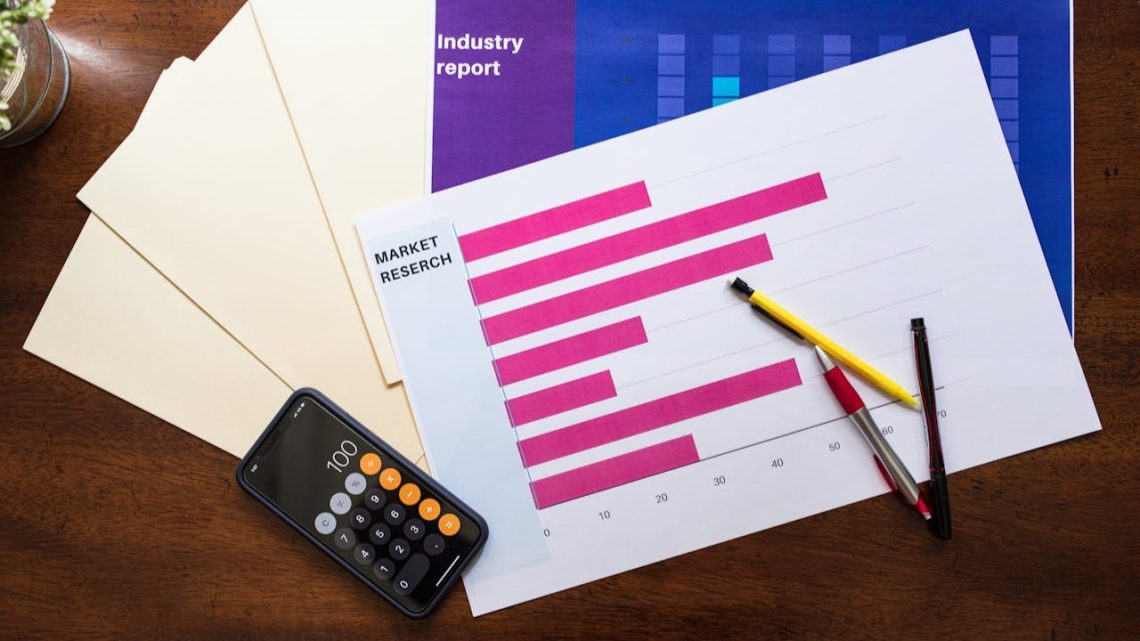More and more people than ever before are shopping online and that also means competition is rising. So, if you are also the owner of an e-commerce store then you must do some market research to keep up with the trends. That’s why you need to check major E-commerce Statistics every year to know what’s working and not working for the customers.
25 E-commerce Statistics for All Online Business Owners
While we can’t predict the future, statistics from industry leaders provide insights into the upcoming e-commerce landscape. Here, we will provide you with some of the important E-commerce statistics and trends for 2025 that are useful for online businesses. So, here we go:
1) From 2024 to 2029, US E-commerce sales are set to rise at 8.9%
Let’s start with what’s happening at the macro level. Despite popular belief that online sales were at their peak during the pandemic, e-commerce sales are set to continuously increase from 2024 to 2029, with a yearly growth rate of 8.9%.
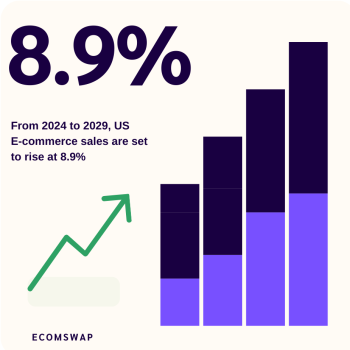
We know that people were shopping from nearby stories after the pandemic, but that didn’t affect online purchases. E-commerce is still a growing market, so there is still scope for growth. This should give you more motivation at a time when there is so much skepticism around the economy.
2) 25% of US consumers use buy now, pay later plans
Now coming to the first major tip for you. Consumers are adopting a new form of payment: Buy Now, Pay Later (BNPL). According to a survey by NerdWallet, around 25% of US consumers used BNPL in 2024. This is a significant jump, especially among the younger generation.
So, it’s a good time to add this new option for your customers. BNPL increases the chances that the customer will buy the product instantly and not delay it for later. However, this also increases the risk of online fraud. We also recommend combining detection and prevention techniques to reduce the risk.
3) 70% of shoppers still abandon their carts
High cart abandonment rates are still a pain point for many online businesses, with 70% of shoppers abandoning their carts before purchase, even in 2024. There are many reasons why this happens, such as hidden charges added later, the website being slow, or unclear return policies. Now is the best time to fix them all to make the checkout experience smoother.
4) 78% of marketers state that customer engagement relies on data
Optimizing the customer experience is refined by data at every touchpoint, with 78% of marketers utilizing data-driven approaches to engage customers. We recommend adopting various approaches, including A/B testing, customer journey mapping, and segmenting customers, for more personalized online interactions.
5) Mobile E-commerce makes up 60% of All online sales
According to Statista report, global mobile e-commerce sales have already reached 60% of all e-commerce sales in 2024. While most of the entrepreneurs have already implemented a mobile-friendly design for their stories, this also means this is high time to make it more friendly.
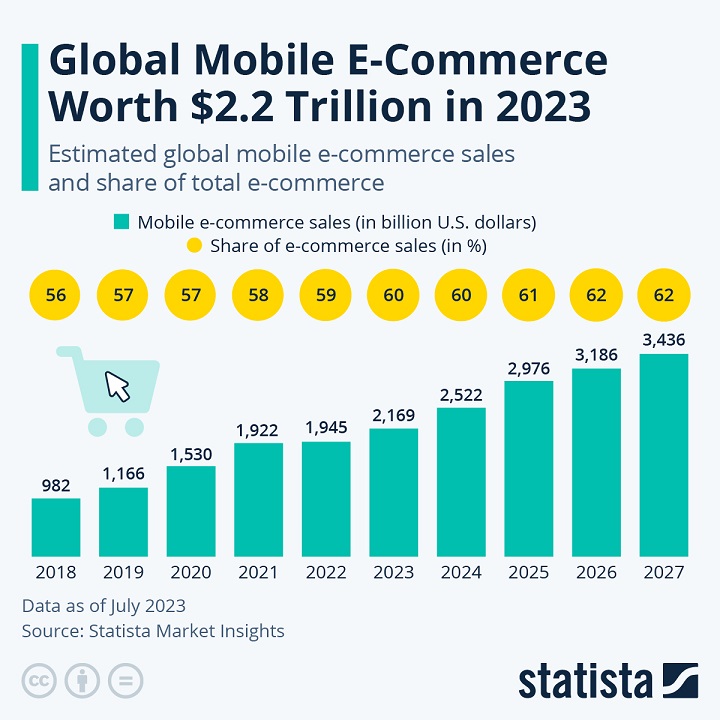
Use high-quality images in the same sizes that you make your social media ads as well as decrease the load time of your site and payment page. Most of the time we tend to focus more on the desktop version as we work on our desktops or laptops and tend to forget that our customers are mainly interacting with the mobile version of the store.
6) The social commerce market will expand to $1.2 trillion by 2025
Millennial and Gen Z social media users love the social commerce thing. Accenture reports that shopping on social media platforms will soar to $1.2 trillion in 2025.
If you want to target a younger demographic, consider bringing your products right to them via social media. You can use live shopping features, create shoppable posts, and try all the social commerce features provided by each platform whether it’s TikTok or Instagram.
7) Online returns will rise in the next decade
Online returns are set to be going to be a major challenge for e-commerce businesses in the coming years as well. 39% of consumers still return an item purchased online at least once per month. While you can never remove the option of return for the customers, there are better ways to combat this problem.
The priority should be optimizing the returns process, whether that means offering exchanges or store credit instead, to minimize losses incurred.
8) 83% of consumers say loyalty programs affect their decision
This is one of the best ways to retain a customer forever and with so many plugins and apps, it has now become so easy to implement. You must have a loyalty program.
Yotpo’s annual State of Brand Loyalty survey reveals that loyalty programs influence the decision to repurchase among 83% of consumers. Retaining customers costs less than acquiring new ones. You can provide rewards points and exclusive discounts to all these loyal customers. However, you need to create a solid brand identity for customers to join your program.
9) 64% of consumers will switch brands if they don’t feel connected
Nowadays, consumers want to know the “why” behind the brand, with 64% of consumers stating they would switch brands if they don’t feel connected to a business’s brand values or mission statement.
For online business owners, get clear on the reason behind the brand. Highlight your mission and priorities across social media and your website.
10) Shopping starts on Search Engines
Even if the person is shopping online or offline, the journey starts online for many of them. According to Klarna Analysis, 44% of potential customers start by searching about the store on Google, Bing, or other search engines. This is the first major touchpoint, followed by official brand websites, physical stores, and social media as well.
11) 99% of consumers read online reviews
While not for every purchase, according to the 2021 Power Reviews report, consumers have made a habit of checking online reviews before purchasing. This can be on Amazon’s product page or the brand’s ratings on Google My Business.
This data is still relevant as the competition is growing and you need more points in your favor. The easiest advice would be to ask the customer to give a review after some days of the purchase. This way, he/she has already tested the product and might be more willing to leave a good word for you.
12) Consumers like Sustainable Products with Transparency
According to a Specright survey, 80% of consumers are more likely to trust brands that provide proof for their sustainability claims with publicly shared data. So, if your products are truly sustainable, you need to tell more about that aspect on your product page and create a separate page on your website showcasing how you are more transparent.
13) 47% of customers like Live Chat
Sometimes, people want to know more about the product before buying it or they might have some issues with returns. So, how can they get in touch with you? For that, you need Live Chat. Hostinger found that around 47% prefer to use Live Chat for customer support. Live Chat is more convenient for them as well as for companies.
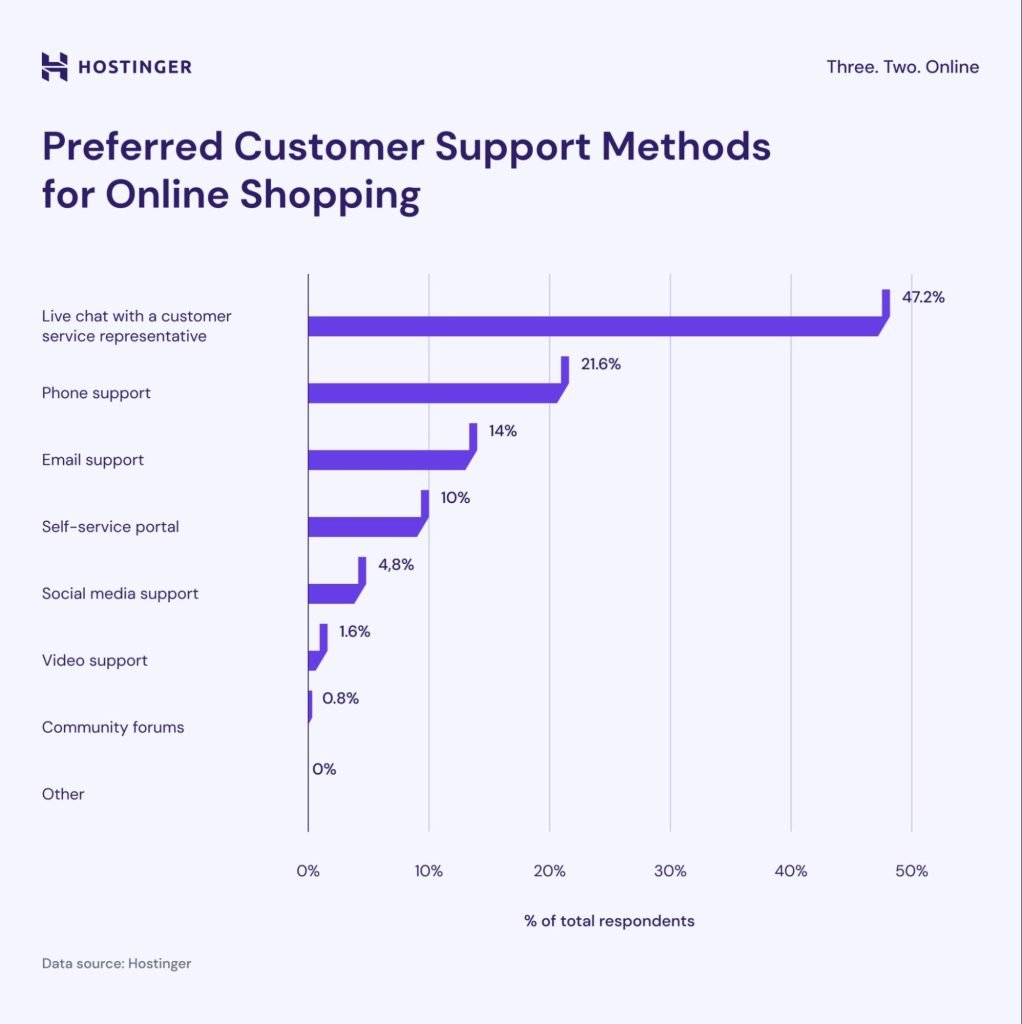
With so many free plugins and apps, it is now very easy to have one for your website. While most service companies have them, e-commerce stores are still behind. So, today is a great day to add this feature.
14) Free Shipping is still the King
Around 62% of shoppers won’t purchase with a retailer without free shipping. This number is increasing every year, so if possible, include free shipping. You can include a minimum cart amount to enable free shipping so that you don’t lose money on small purchases.
15) Voice Commerce coming soon
The global voice commerce market size is expected to grow at a CAGR of 24.6% from 2024 to 2030. When smart speakers are growing in sales and smartphones are coming up with more voice features, this is a big market in which you can be the first adopter.
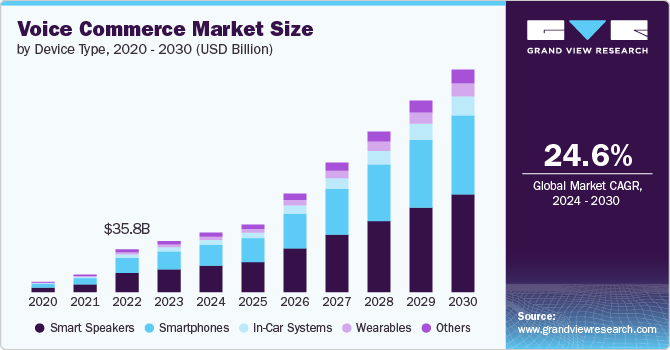
You can optimize your SEO for voice search, implement voice-activated navigation, and create an app for Alexa or Google Assistant.
16) 52% of Shoppers gone Global
If you are looking to expand to new territories, this is your time. The tools and shipping services are already there making it more convenient for any store to deliver products worldwide. Shoppers are ready too because according to a survey by Nosto, 52.45% of respondents had purchased from an e-commerce store based in another country in the last year.
17) B2B Sales to Reach $20 Trillion by 2027
If you are in a Business-to-Business E-commerce space, then there is still a lot of growth ahead. The global B2B e-commerce market size is estimated to reach $20.9 trillion by 2027 with a CAGR of 17.5% from 2020. Global markets are changing everything, you don’t know what new opportunities you might uncover.
18) E-mail Marketing’s ROI is 3600%
Most new people now focus more on social media and influencer marketing. That’s good! But the age-old E-mail marketing is still effective if done correctly. According to Litmus, For every $1 marketers spend on email marketing, they receive $36 in return.
New e-commerce store operators think that E-mail is dead or they should not focus on it as young buyers don’t check their emails anymore. But that’s not the case. While we are not saying, you should just focus on e-mail marketing, you must have it a part of your system. It’s easy to set up and very cheap to use. With an ROI of 3600%, we think now you will for sure.
19) Fast Delivery means 2 Days or Less
While same-day delivery is the new trend, not every business can afford or manage it. But shoppers don’t like to wait and if you are promoting Fast Delivery on your website, that should mean less than 48 hours. According to a new study by OnTrac, 86% of consumers define fast delivery as two days or less.
If you are taking more time than that, you should mention that on the checkout page. Also, if you can, you should offer fast delivery options to your customers, as they are willing to pay shipping charges for that.
20) Influencer-founded businesses are growing rapidly
Social media influencers are no longer just talking about other businesses’ products, they are creating their own companies. You have seen MrBeast selling chocolates and Logan Paul selling PRIME soft drinks. Morning Consult found that nearly 30% of US consumers have purchased a product from such an influencer brand in the last year.
Even if you are not an influencer, this means that you need to become one this year. You can talk about your products and industry to educate the customers. This way, they will also know who is behind the business and might get attached to it.
21) Consumers compare prices even when shopping offline
While physical stores are still there and running smoothly, consumers are still taking out time to see if online stores have better deals. Around 72% of consumers research price comparisons while shopping in a physical store in North America. Price is a big factor that they can’t ignore and you shouldn’t also. This is a positive sign for e-commerce growth.
22) Florida is the best state for E-commerce
Thinking of moving your business somewhere else, or you haven’t started one? Then, you must know what is the best place to set up your operations.
Nexcess ranked Florida as the best state for e-commerce business, while Utah and North Carolina were 2nd and 3rd.
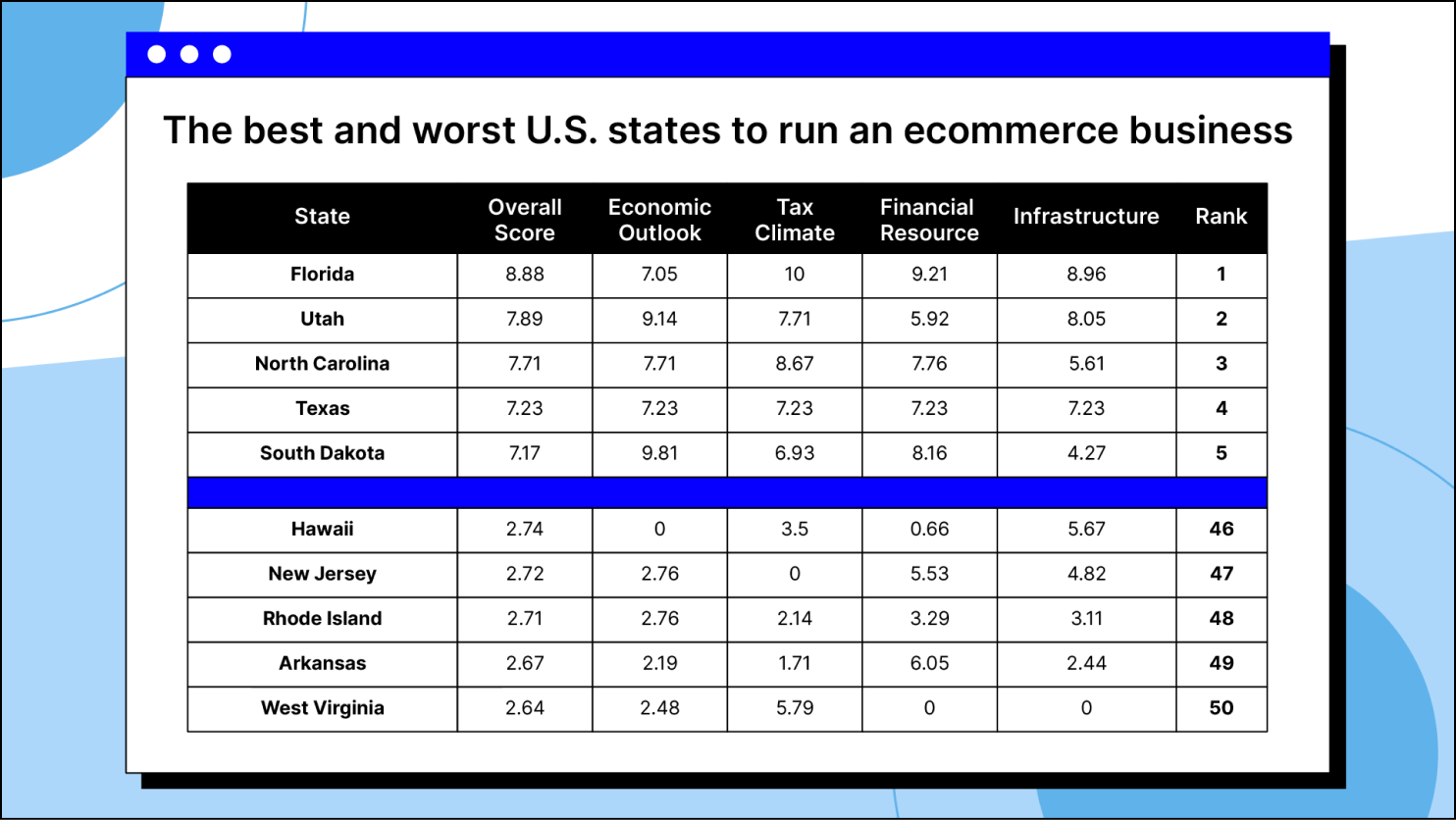
This was based on factors like economic outlook, infrastructure, and local taxes. At the bottom of the list were West Virginia and Arkansas.
23) Fast websites have 2.5x More Conversions
People don’t like to wait and for e-commerce stores, that means the loading speed of the website should be fast. Portent found that A website that loads in 1 second has a 2.5 times higher conversion rate than another website that loads in 5 seconds. Decreasing the loading times will surely bump up your sales as well as your SEO rankings.
24) People shop when they are on their beds
This is just a fun fact! BigCommerce survey found that 43% of shoppers have purchased something online while they were in bed. But a valuable data insight from this survey is that around 25% did online shopping while they were in a brick-and-mortar shop. This means that even if the consumer is at a store, they will still want to look for better prices online.
25) Subscription market will be $5014 Billion by 2032
IMARC Group predicts that the subscription e-commerce market to reach US$ 5,014.4 Billion by 2032 with a CAGR of 43.56% during 2024-2032. This is a huge opportunity that you must do before your competitors do it.
If your product is something that customers need to buy every month or so, then you must provide a subscription during checkout. You can provide big discounts and value-added content for subscribers to entice them to continue shopping from you in the future.
Get the best price for your business — we take care of the rest.
Start Selling for FreeTakeaways
These are all the important statistics and trends you need to know if you are running an e-commerce business. Not only did we provide you with the insights, but we also tried to include some tips on what you should do. Little changes can make a huge difference in your sales! But if you still haven’t started your store, you might buy an online business from someone else.

